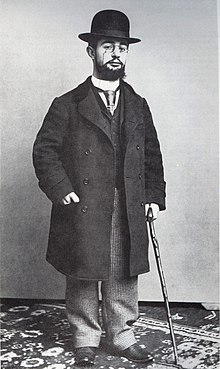Henri Toulouse-Lautrec
| Henri de Toulouse-Lautrec | |
|---|---|
 |
|
| Born |
Henri Marie Raymond de Toulouse-Lautrec-Monfa 24 November 1864 Albi, Tarn, France |
| Died | 9 September 1901 (aged 36) Saint-André-du-Bois, France |
| Resting place | Cimetière de Verdelais |
| Nationality | French |
| Education | René Princeteau, Fernand Cormon |
| Known for | painting, printmaking, drawing, draughting, illustration |
| Movement | Post-Impressionism, Art Nouveau |
Henri Marie Raymond de Toulouse-Lautrec-Monfa (24 November 1864 – 9 September 1901), also known as Henri de Toulouse-Lautrec (French: [ɑ̃ʁi də tuluz lotʁɛk]) was a French painter, printmaker, draughtsman and illustrator whose immersion in the colourful and theatrical life of Paris in the late 19th century allowed him to produce a collection of enticing, elegant and provocative images of the modern, sometimes decadent, life of those times. Toulouse-Lautrec is among the best-known painters of the Post-Impressionist period, with Cézanne, Van Gogh and Gauguin. In a 2005 auction at Christie's auction house, La Blanchisseuse, his early painting of a young laundress, sold for US$22.4 million and set a new record for the artist for a price at auction.
Henri Marie Raymond de Toulouse-Lautrec-Monfa was born at the Hôtel du Bosc in Albi, Tarn in the Midi-Pyrénées region of France, the firstborn child of Count Alphonse Charles de Toulouse-Lautrec-Monfa (1838–1913) and wife Adèle Zoë Tapié de Celeyran (1841–1930). The last part of his name means he was a member of an family (descendants of the Counts of Toulouse and Odet de Foix, Vicomte de Lautrec and the Viscounts of Montfa, a village and commune of the Tarn department of southern France, close to the cities of Castres and Toulouse). His younger brother was born in 1867, but died the following year.
...
Wikipedia
